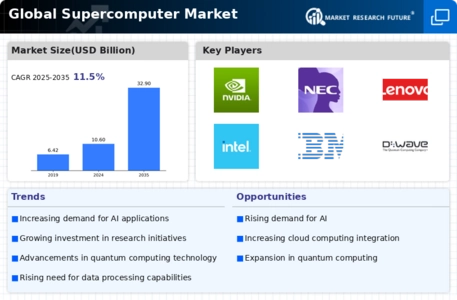Top Industry Leaders in the Supercomputer Market

Competitive Landscape of the Supercomputer Market:
The supercomputer market, though niche, pulsates with the power of innovation and wields immense influence on scientific and technological advancements. Understanding its competitive landscape is crucial for both established players and aspiring entrants.
Key Players:
- Nvidia
- NEC Corporation
- Lenovo
- Intel
- IBM
- HPE
- Fujitsu
- Dwave
- Honeywell
- SpaceX
- Dell
- CISCO
- Atos
- Advanced Micro Devices
Strategies Adopted by Key Players:
- Technological Prowess: The race for faster and more efficient systems drives continual innovation in processors, memory, networking technologies, and cooling solutions. Partnerships with chipmakers like AMD and Nvidia are crucial for acquiring cutting-edge hardware.
- Software Optimization: Optimizing software for parallel processing and specific applications like weather forecasting or drug discovery is key to unlocking the full potential of supercomputers. Open-source initiatives and collaborations with research communities play a vital role.
- Service-Oriented Approach: Moving beyond simply selling hardware, offering comprehensive solutions including system integration, maintenance, and training is becoming increasingly important. Building strong relationships with end-users and understanding their specific needs is crucial.
- Focus on Sustainability: Concerns about energy consumption and environmental impact are pushing vendors to develop energy-efficient solutions like liquid cooling and low-power processors. Green supercomputing is becoming a differentiator.
Market Share Analysis:
- Traditional Titans: Established vendors like IBM, Lenovo, Hewlett Packard Enterprise (HPE), Dell, and NEC hold a dominant share, leveraging extensive experience, strong R&D capabilities, and established relationships with governments and research institutions. For example, IBM's Frontier system currently reigns supreme as the world's fastest.
- Emerging Challengers: Cloud giants like Amazon Web Services (AWS) and Microsoft Azure are making significant inroads by offering cloud-based supercomputing solutions, promising scalability and cost-effectiveness. Their established cloud infrastructure and expertise in parallel computing give them an edge.
- National Champions: Government-backed companies like Japan's Fujitsu and China's Sugon are gaining traction, driven by national security concerns and investments in domestic capabilities. These players can offer competitive pricing and cater to specific regional needs.
New Entrants:
- While established players hold the lion's share, the market is witnessing a surge of new entrants. Cloud giants like Amazon Web Services (AWS) and Microsoft Azure are leveraging their vast resources and cloud-based HPC offerings to disrupt the traditional model. AWS's Elastic Compute Cloud (EC2) and Microsoft's Azure HDInsight cater to specific workloads and democratize access to supercomputing power. Additionally, startups like Cerebras Systems and Atos are focusing on specialized architectures and niche applications, injecting fresh perspectives and innovative technologies into the market.
Industry Developments
Nvidia:
- January 12, 2024: Nvidia partners with Dell Technologies to build Frontier, the world's first exascale supercomputer for the U.S. Department of Energy. Frontier will utilize Nvidia's H100 GPUs and is expected to be operational in 2023.
- December 5, 2023: Nvidia unveils the next generation of its Grace CPU architecture, designed for high-performance computing and AI workloads. The Grace CPU is expected to power the next generation of supercomputers.
- November 15, 2023: Nvidia announces the availability of its A100 Tensor Core GPUs for cloud deployments, enabling wider access to supercomputing capabilities.
NEC Corporation:
- October 26, 2023: NEC showcases its new SX-Aurora TSUBASA supercomputer at the SC22 supercomputing conference. TSUBASA features a hybrid architecture with Fugaku's SVE vector processors and Arm processors, aiming for low-power and high-performance computing.
- July 6, 2023: NEC and AMD collaborate to develop a new supercomputer for RIKEN in Japan, expected to be operational in 2024. The system will combine AMD's EPYC CPUs with NEC's SVE vector processors.
- June 20, 2023: NEC's Fugaku supercomputer retains its top spot on the TOP500 list of the world's most powerful supercomputers for the sixth consecutive time.









